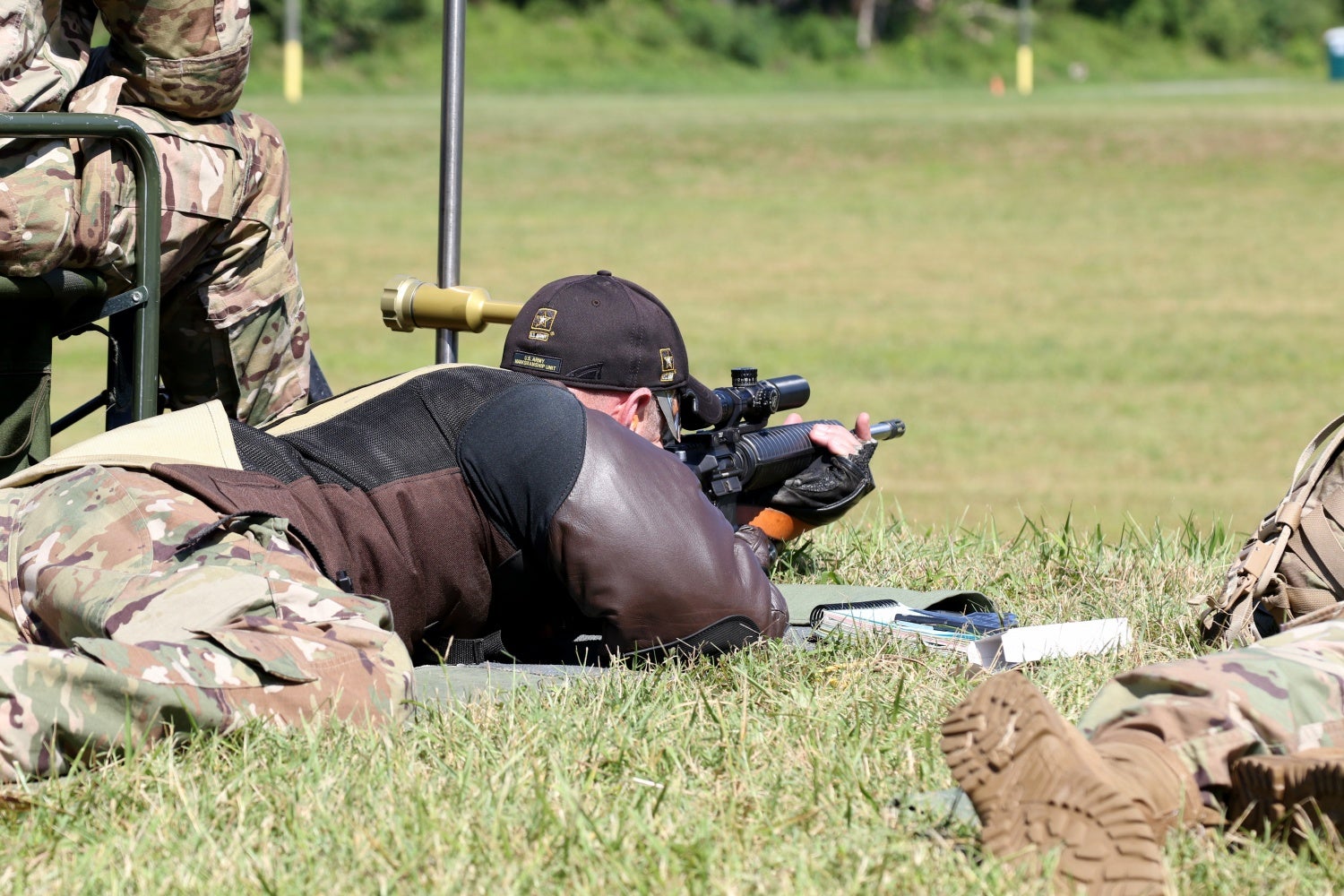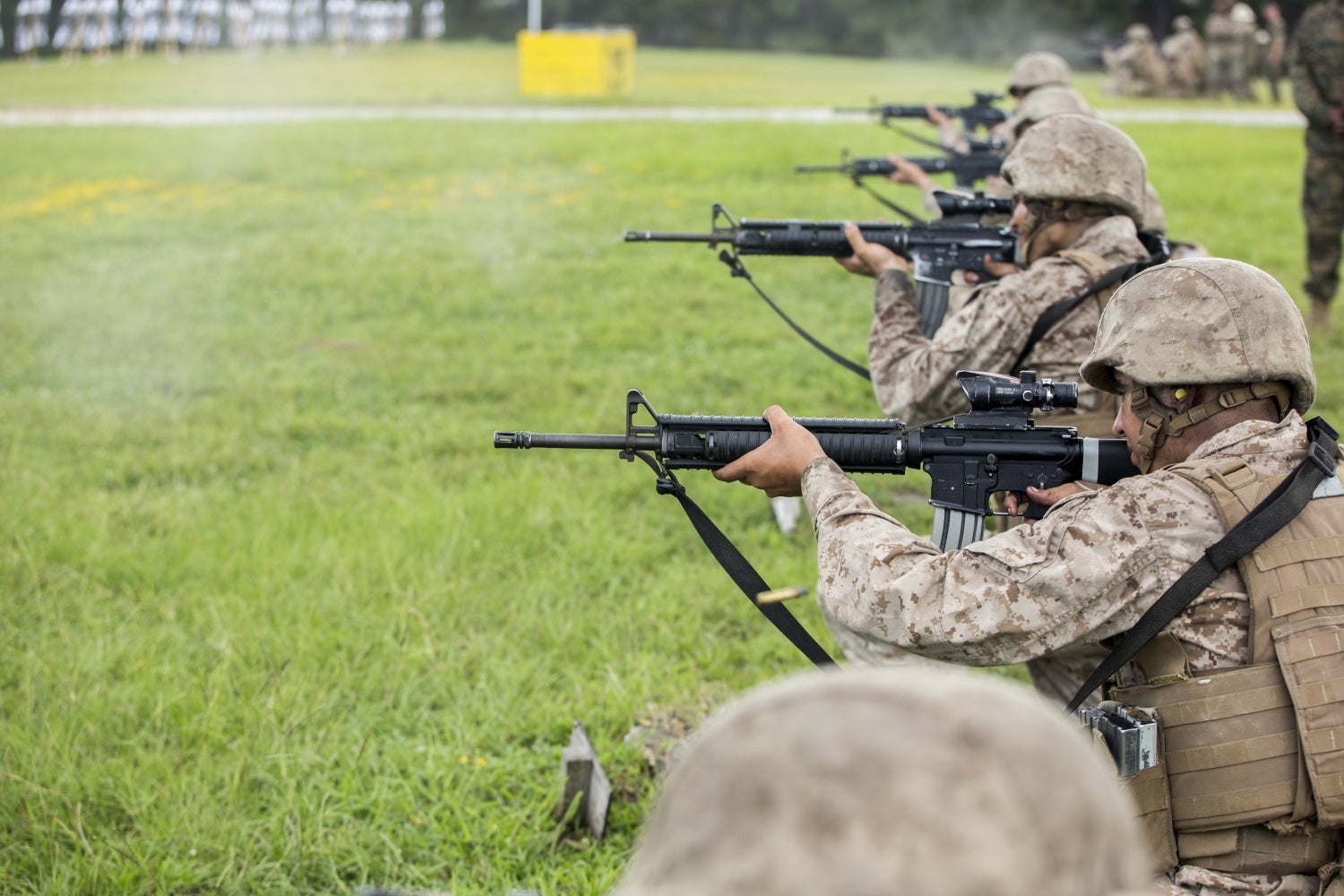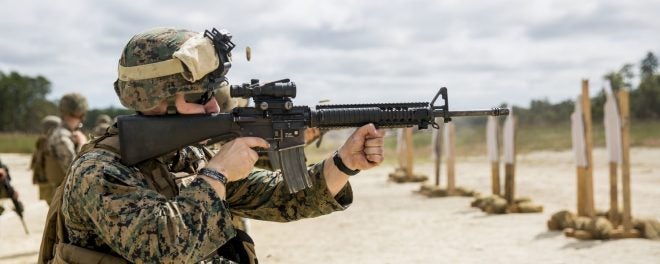In examining the future of infantry capability, we must not only be aware of potential technological solutions, but of the need to re-think and re-work what it means to train and prepare troops for future battlefields. At the core of this is the simple matter of man and rifle, of marksmanship.
Yet in this, we in the general conversation have done ourselves a disservice: We have pitted against itself a false dichotomy of extremes. One the one hand, a view that young men are simply too unreliable, too unsteady to be precision platforms, and thereby can’t be lethal beyond a couple hundred meters. On the other, a gospel that we have lost our way, and the true answer is precision long range marksmanship for every soldier and Marine. In this article, I hope to present an alternate – and more true to life – view, and in doing so inject some clarity of thought into the picture of infantry marksmanship moving into the mid 21st Century. Now, let us consider what is in the gripping hand.

Original caption: “U.S. Air Force Staff Sgt. Ryan Saltzgaber, a tactical air control party specialist assigned to the 3rd Air Support Operations Squadron, fires a M4 carbine during live-fire sustainment training at Joint Base Elmendorf-Richardson, Alaska, Sept. 28, 2017.” U.S. Air Force photo by Alejandro Peña, public domain.
The core of our revision is this: It is not true that infantry cannot be trained above the current lackluster standard, but neither is it reasonable to expect them to inflict terror at ranges out to a kilometer and beyond. It is true that a much higher degree of lethality through superior general marksmanship is possible than what is achieved now with the standards of the Army (and the Marine Corps too, although to a lesser extent), and yet simultaneously true that the expense and cost of producing general lethality in the ranks at distances beyond 500 meters is prohibitive. Therefore, the most pragmatic approach to improving lethality through marksmanship is to emphasize precise fires at distances 500 meters and closer.
Why is this, though? The truth is that the accepted dichotomy conflates two separate disciplines which each require separate skill sets. The first, we might call “foundational marksmanship”. This is the same basic set of practices already taught today – the same positions, the same fundamentals of aiming, breath control, trigger squeeze, etc. that are taught in virtually every military and civilian marksmanship class in the country. Foundational marksmanship is simple, and is built primarily on repetition, reflexes, and muscle memory. It is easy to learn, and easy to maintain. Almost anyone in good health can build the necessary skills, which then live in the hindbrain until called upon. It is, of course, possible to lose these skills with enough atrophy, but to truly lose them forever takes a long time. I have seen these skills quickly return in others, even after decades of being dormant.

Original caption: “Sgt. 1st Class Brandon Green, a shooter/instructor with the U.S. Army Marksmanship Unit, fires his service rifle during the Interservice Championships in Quantico, Virginia on July 31, 2017.” .S. Army photo by Michelle Lunato, public domain.
However, foundational marksmanship does not give shooters the tools to become truly lethal at long range. The basic curriculum does not include calculations on wind and drift, explanations of parallax, etc. Distance shooting is a body of knowledge unto itself, and a far more rare one. The patterns and memories it uses reside in the frontal lobe, and are therefore more difficult to learn, and more difficult to maintain. We might say that foundational marksmanship is like “riding a bike”; distance shooting, like calculus, is different. The expectation that the general body of troops could together learn to shoot and hit consistently at the distances where wind, drop, temperature, and other environmental factors play their largest part is simply unrealistic. This is not to say that some people cannot learn this – they can and they do. Yet, those that do are at the range honing their skills as often as most of us take a night out, and they fire tens of thousands of rounds of ammunition every year to maintain those skills. Simple math tells us this would be untenable for general recruits: Even assuming only the 200,000 or so combat infantry receive the training necessary to achieve and maintain this degree of effectiveness, that still implies a training budget of 3 billion rounds spent per year, which is several times the total annual ammunition budget (training and combat) of the entire US Armed Forces.
Our focus returns to foundational marksmanship, then; and it is here that we see room for improvement. We see that today’s Army marksmanship qualification is incapable of scoring finer precision than about 7 minutes of angle – a soundly mediocre value for a rifleman. Any shooter who is this precise or better when qualifying will achieve the highest grade (“Expert”) virtually without fail. Without any standard beyond this, there is no incentive for anyone – much less everyone – to perform any better than this, and many who pass their qualifications perform much, much worse. Higher standards than this are certainly possible. Implementing such standards as part of a well-designed program would mean more precise fires and higher combat lethality.

“U.S. Marine Corps recruits of Charlie Company, 1st Recruit Training Battalion, shoot during marksmanship training Aug. 30, 2017, on Parris Island, S.C.” U.S. Marine Corps photo by Lance Cpl. Maximiliano Bavastro, public domain.
One expert I spoke with suggests a simple method for cementing lessons on short-range precision: “Put two recruits into a shoot house, give them marker rounds and headshots only rules, and keep them there until they learn to slow down and aim. After taking fifty, a hundred shots to the body, they’ll figure it out. ‘The pain will continue until understanding improves’. It’s simple, inexpensive, and it works. Suddenly, aiming isn’t dumb anymore.” This can’t be a replacement for basic marksmanship, but rather helps to give the infantryman the toolset, the calmness and ability to take their time quickly, to utilize those marksmanship fundamentals in the field. What sort of standard does he suggest? “Marksmanship ability ideally would be 2.5 MOA or better. An NRA B8 Bullseye is about the size of the heart or brain, we should train to hit that consistently at 100 meters.” A tall order, to be sure – but probably not impossible with a good rifle and ammunition.
In history, we see the difference higher general marksmanship standards can make. At the dawn of the 20th Century, the British Army understood the value of marksmanship training, which they called “musketry” then. The hard lesson of precise individual fires was inflicted upon them in their engagements with the Boers beginning in 1899. By the first year of the Great War, the British Expeditionary Force (BEF) had met the Imperial German Army in the field. At Jemappes during the Battle of Mons, they successfully held off the German advance through the application of fine marksmanship which the Prussian troops could not equal. The distances in the fights at Mons were not long, but the fires of the British rifles were very precise and lethal – so lethal, the anecdote goes, many Germans believe they were facing machine guns, not riflemen.

“U.S. Marine Corps Cpl. Luis A. Chavez, a low altitude air defense (LAAD) gunner with 2nd LAAD Battalion, fires a M16A4 rifle during combat marksmanship training on Camp Lejeune, N.C., Sept. 26, 2017.” U.S. Marine Corps photo by Lance Cpl. Cody J. Ohira, public domain.
The 21st Century will bring its challenges to the Infantry, and it is up to the planners of today to foresee and meet those challenges as best they can. To them, future war already presents a daunting picture of troops operating in sprawling urban areas, dealing with both friendly and enemy networked and autonomous systems, and surviving in a landscape with a character unlike any historical battlefield we know. That future is coming sooner than we’d like to think – in many ways it is already here. Accepting the current marksmanship standards may not be enough, but expecting general troops to put accurate fires on targets a kilometer or more away is unrealistic. Maybe accurate close range fires through mastery of foundational marksmanship is the answer.
 Your Privacy Choices
Your Privacy Choices
